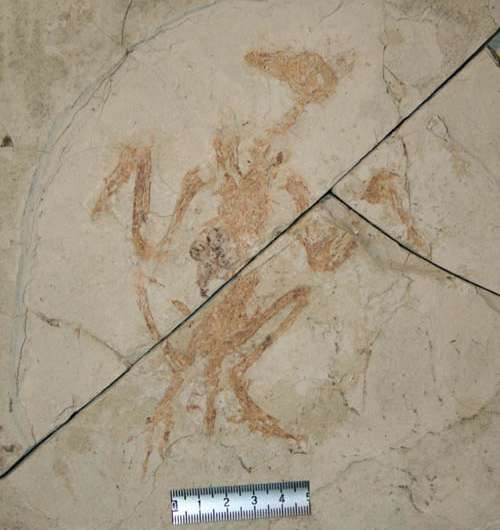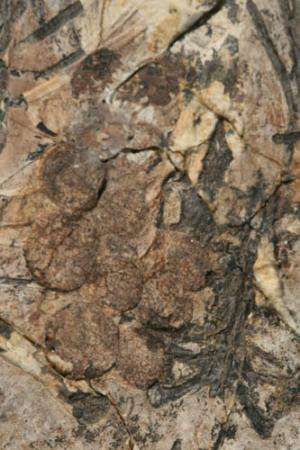March 18, 2013 report
Paleontologists discover fossilized ovarian follicles in three birds from Early Cretaceous

(Phys.org) —A team of paleontologists with the Chinese Academy of Sciences in Beijing has discovered what are believed to be fossilized ovarian follicles in three birds from approximately 125 million years ago. As they describe in their paper published in the journal Nature, one of the birds appears to be a known type—Jeholornis—a bird from the Early Cretaceous that retained some non-avian features. The other two specimens were not well enough preserved to identify.
Scientists have for many years been interested in learning more about how it was that birds evolved avian traits distinct from non-avian dinosaurs—one of which was the change from two ovaries to just one. Modern crocodiles for example, have two, whereas all modern birds have just one (on the left side). It is believed this change came about to help reduce weight for flying females. Researchers have found fossilized pre-avian bird samples, called maniraptorans, which are in essence, flying dinosaurs, but evidence of birds from the time when the changeover was occurring has been scant. Fossilized bird specimens with traits retained from their forebears, such as the bony tail found with Jeholornis, are rare as are those where the single ovary can be seen. In this new discovery, all three birds have what appear to be not just single ovaries, but follicles (structures within ovaries that hold developing eggs) inside of them.

The researchers have deduced that the structures they've discovered are follicles by eliminating the possibility that they are something else, such as seeds or rocks, rather than by proving it through analysis—their placement in the body (on the left side), for example, their shape and size, and the fact that they were compressed flat along with the rest of the body as they fossilized (indicating they were of soft material), all point to follicles similar to those found in modern birds. Also their numbers indicate that early birds produced far more eggs than is common with birds today—one of the specimens had 20 follicles—a sign of not just a large clutch, but of small eggs and possibly protection and care given by males. They also noted that some of the bones of one of the birds had not fused, indicating that early birds were likely able to reproduce at a younger age than modern birds as well.

More information: Preservation of ovarian follicles reveals early evolution of avian reproductive behaviour, Nature (2013) doi:10.1038/nature11985
Abstract
The two groups of archosaurs, crocodilians and birds, form an extant phylogenetic bracket for understanding the reproductive behaviour of dinosaurs. This behaviour is inferred from preserved nests and eggs, and even gravid individuals. Data indicate that many 'avian' traits were already present in Paraves—the clade that includes birds and their close relatives—and that the early evolution of the modern avian form of reproduction was already well on its way. Like living neornithine birds, non-avian maniraptorans had daily oviposition and asymmetrical eggs with complex shell microstructure, and were known to protect their clutches. However, like crocodilians, non-avian maniraptorans had two active oviducts (one present in living birds), relatively smaller eggs, and may not have turned their eggs in the way that living birds do. Here we report on the first discovery of fossilized mature or nearly mature ovarian follicles, revealing a previously undocumented stage in dinosaur reproduction: reproductively active females near ovulation. Preserved in a specimen of the long bony-tailed Jeholornis and two enantiornithine birds from the Early Cretaceous period lacustrine Jehol Biota in northeastern China, these discoveries indicate that basal birds only had one functional ovary, but retained primitive morphologies as a result of their lower metabolic rate relative to living birds. They also indicate that basal birds reached sexual maturity before skeletal maturity, as in crocodiles and paravian dinosaurs. Differences in follicular morphology between Jeholornis and the enantiornithines are interpreted as forming an evolutionary gradient from the reproductive condition in paravian dinosaurs towards neornithine birds. Furthermore, differences between the two enantiornithines indicate that this lineage might also have evolved advanced reproductive traits in parallel to the neornithine lineage.
Journal information: Nature
© 2013 Phys.org

















